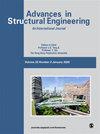Comparative study of two-phase flow approaches for modeling conjugate heat transfer in a three-dimensional wavy microchannel-heat sink with CuO-water nanofluid
IF 2
4区 工程技术
引用次数: 0
Abstract
This study aims to numerically investigate the conjugate heat transfer (CHT) and the changes in the hydraulic and thermal terms of laminar flow (300 ≤ Re ≤ 800) in a 3-D wavy microchannel heat sink (MCHS). The obtained results from different nanofluid flow simulated models will be compared. The numerical simulation approaches used include single-phase, mixture, Eulerian, DPM, and DDPM. The effect of adding 1%, 3%, and 6% concentration of CuO nanoparticles (100 nm) in deionized water as the base fluid is examined on various parameters such as local and axial temperature, heat transfer convective coefficient, friction factor, Nusselt number (Nu), velocity distribution, and thermal and hydraulic boundary layer parameters. The substrate surface, due to its larger area surface and the amplitude of the sinusoidal wave, has a greater impact on the nanofluid flow as a channel bottom conjugate surface compared to others. The results obtained from the different models show close agreement with each other for various cases. For example, at Re = 304, the average Nu and friction factor for pure water are approximately 10.43 and 0.0260, respectively. For water with 0.01 concentration of CuO nanoparticles, Nu is found to be in the range of 10.43–10.78, and the friction factor ranges from 0.260 to 0.290, depending on the approach used for simulation. This shows a 2% increase in Nusselt number compared to a 0.05% increase in the friction factor. Moreover, these values increase by approximately 5.7% and 11.3% on average with an increase in CuO nanoparticle concentration to 0.06. Additionally, the DPM and DDPM models show a 15% difference in the scattering of CuO nanoparticles compared to the Eulerian-Eulerian models. The single-phase model presented in this study yields similar results to the multiphase approaches. Furthermore, the PEC parameter increases by about 1.9% with the addition of CuO nanoparticles at a concentration of 0.06.对采用氧化铜-水纳米流体的三维波浪形微通道-散热器中共轭传热建模的两相流方法进行比较研究
本研究旨在对三维波浪形微通道散热器(MCHS)中层流(300 ≤ Re ≤ 800)的共轭传热(CHT)以及水力和热力项的变化进行数值研究。将对不同纳米流体流动模拟模型的结果进行比较。使用的数值模拟方法包括单相流、混合流、欧拉流、DPM 和 DDPM。研究了在去离子水中添加 1%、3% 和 6% 浓度的氧化铜纳米粒子(100 nm)作为基础流体对各种参数的影响,如局部和轴向温度、传热对流系数、摩擦因数、努塞尔特数 (Nu)、速度分布以及热和水力边界层参数。与其他表面相比,作为通道底部共轭表面的基底表面由于其较大的面积表面和正弦波的振幅,对纳米流体流动的影响更大。在不同情况下,不同模型得出的结果显示彼此非常接近。例如,在 Re = 304 时,纯水的平均 Nu 和摩擦因数分别约为 10.43 和 0.0260。对于含有 0.01 浓度氧化铜纳米粒子的水,Nu 在 10.43-10.78 之间,摩擦因数在 0.260 到 0.290 之间,具体取决于所用的模拟方法。这表明,与摩擦因数增加 0.05% 相比,努塞尔特数增加了 2%。此外,随着 CuO 纳米粒子浓度增加到 0.06,这些数值平均增加了约 5.7% 和 11.3%。此外,与 Eulerian-Eulerian 模型相比,DPM 和 DDPM 模型显示 CuO 纳米粒子的散射相差 15%。本研究提出的单相模型得出的结果与多相方法相似。此外,加入浓度为 0.06 的氧化铜纳米粒子后,PEC 参数增加了约 1.9%。
本文章由计算机程序翻译,如有差异,请以英文原文为准。
求助全文
约1分钟内获得全文
求助全文
来源期刊

Advances in Mechanical Engineering
Engineering-Mechanical Engineering
自引率
4.80%
发文量
353
期刊介绍:
Advances in Mechanical Engineering (AIME) is a JCR Ranked, peer-reviewed, open access journal which publishes a wide range of original research and review articles. The journal Editorial Board welcomes manuscripts in both fundamental and applied research areas, and encourages submissions which contribute novel and innovative insights to the field of mechanical engineering
 求助内容:
求助内容: 应助结果提醒方式:
应助结果提醒方式:


